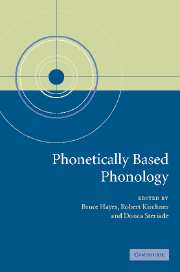Book contents
- Frontmatter
- Contents
- List of contributors
- List of abbreviations
- 1 Introduction: the phonetic bases of phonological Markedness
- 2 A review of perceptual cues and cue robustness
- 3 Place assimilation
- 4 The typology of rounding harmony
- 5 The evolution of metathesis
- 6 The role of contrast-specific and language-specific phonetics in contour tone distribution
- 7 Vowel reduction
- 8 Contrast and perceptual distinctiveness
- 9 Syllable weight
- 10 Consonant lenition
- 11 Language processing and segmental OCP effects
- Index
1 - Introduction: the phonetic bases of phonological Markedness
Published online by Cambridge University Press: 21 October 2009
- Frontmatter
- Contents
- List of contributors
- List of abbreviations
- 1 Introduction: the phonetic bases of phonological Markedness
- 2 A review of perceptual cues and cue robustness
- 3 Place assimilation
- 4 The typology of rounding harmony
- 5 The evolution of metathesis
- 6 The role of contrast-specific and language-specific phonetics in contour tone distribution
- 7 Vowel reduction
- 8 Contrast and perceptual distinctiveness
- 9 Syllable weight
- 10 Consonant lenition
- 11 Language processing and segmental OCP effects
- Index
Summary
If phonological systems were seen as adaptations to universal performance constraints on speaking, listening and learning to speak, what would they be like?
Lindblom (1990: 102)Introduction
Our starting point is a hypothesis central to contemporary phonology: that the markedness laws characterising the typology of sound systems play a role, as grammatical constraints, in the linguistic competence of individual speakers. From this assumption, a basic question follows:How are grammars structured, if markedness laws actively function within them as elements of linguistic competence? We find the answer offered by Optimality Theory (Prince and Smolensky 1993) worth investigating: the grammatical counterparts of markedness laws are ranked and violable constraints and the latter form ‘the very substance from which grammars are built: a set of highly general constraints which, through ranking, interact to produce the elaborate particularity of individual languages’ (Prince and Smolensky 1993: 217). With qualifications, this view is adopted by many of the contributions to this volume.
The focus of our book is on a different, complementary question: Where do markedness laws come from? Why are sound systems governed by these laws and not by some conceivable others? What is the source of the individual's knowledge of markedness-based constraints? The hypothesis shared by many writers in this volume is that phonological constraints can be rooted in phonetic knowledge (Kingston and Diehl 1994), the speakers' partial understanding of the physical conditions under which speech is produced and perceived. The source of markedness constraints as components of grammar is this knowledge. The effect phonetic knowledge has on the typology of the world's sound systems stems from the fact that certain basic conditions governing speech perception …
- Type
- Chapter
- Information
- Phonetically Based Phonology , pp. 1 - 33Publisher: Cambridge University PressPrint publication year: 2004
- 87
- Cited by



